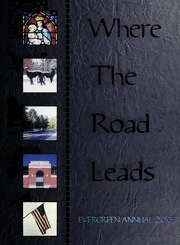Table Of ContentDigitized by the Internet Archive
in 2017 with funding from
Loyola University Maryland, Office of Academic Affairs
https://archive.org/details/evergreenannual00loyo_18
Where
Ro^d
the Leads
Evergreen Annual 2003
It’s wild and ^^y^tfn^^^xfeiteih&rfc^t’s packing the bleachers
at the Fall Football Classic and singing along with Guster. It’s
STUDENT
LIFE.
It’s down and dirt^e^F+vpfetitfoV^ for one and one for all. It’s
scoring the final goal in the lacrosse game at Hopkins. It’s
SPORTS.
It’s your ts in the Greyhound
office and tables outside of Boulder. It’s giving back to a commu-
nity that has given you so much. It’s ORGANIZATIONS.
^4
It’s the rigorous Jesuit experience-eight o’clock classes and ser-
vice learning. It’s turning in your fifteen-page paper on a rainy
Friday morning. ACADEMICS.
It’s
•%
It’s finding unity in diversity-learning to smile through the hard
times. It’s bonding at 2am with your best friend and a carton of
UNDERCLASSMEN.
ice cream. It’s
t^^^he^ur^belh§=d14e
It’s looking top dog. It’s the last
class, the last dance, the last walk over the bridge, the last din-
ner at Primos. It’s SENIORS.
^
J
It’s parentaf#f§dH^fT; si^M,''9e%rl%5lr> cP-delivered. It’s that
baby picture that your mother promised she wouldn’t send in.
SENIOR FAREWELLS.
It’s
gy the Greyhound PeteWenger, Dana Matthews, Matt Midnight Mayhem
Montemurno, Michele Riverso
- 1
The Humanities buildinOg
Where served many purposes,
containing faculty offices,
classrooms, computer labs, a
dining area, and many other
departmental offices.
The
Unfortunately, its interior
structure wasn’t exactly easy
to get usedto. It took many
students their entire four
Road
years at Loyola to master the
confusing hallways.
Le<ads
This view from Loyola’s bridge shows North Charles Street on abeautiful fall day. During students’ walk to and from classes, Charles Street
offered a view ofbusy city traffic, seasonal changes, and occassionally a good friend. The sidewalks ofNorth Charles were also frequented by Loyola
students traveling to the Fitness and Aquatic Center on foot as opposed to the popular shuttle system.
Loyola’s history continued this year, as its four thousand students, fac-
ulty and staff marched through another couple of semesters, a few
concerts, dozens of sporting CVCITtS, numerous retreats, and thou-
sands of meetings. A parade of activity, the campus was a new adven-
work
ture for freshmen, while upperclassmen were hard at and se-
We
niors cruised toward graduation. were always together, whether
We
eating meals or taking road trips. sometimes ran through potholes
detours
and had to take when we lost the directions. We kept
maps
in our pockets, but sometimes thought it better to make a left
turn even if we should have made a right one. We kept all the appropri-
travel professors
ate logs, turning them into our at the end
of long semesters, and surprised even ourselves with the extent of what
we had learned. We decided our destinations with confidence and in
sparkled
the end, we discovered that our time here with an en-
thusiasm that could only be found on a college campus, at a small
priest
school where a owned and walked the mascot, where the
campus
people on Fate Date were our friends, where the police re-
port was the most exciting part ofTuesdays, and where our best friends
were part of our eight am daSSCS. This was Loyola in 2003, the
vehicle that drove us into our future.
IStudents enjoy the fall concert,
Custer, during the band's closing
song.
1Sophomores Jenn Krempecki HiACampiongirlmakesfulluseof
:
and Kristen Kearby take a break a Primo's tray and the Pit's hill on
from a movie night on the Quad. one ofmany snow days.
"Security is mostly a superstition.
It does not exist in nature, nor do
the children of man as a whole
IIncostumesforHalloween,Nick
Buschar and Michelle Pearl put on experience it. Avoiding danger is no
differentpersonalitiesforanightof
fun.
safer in the long run than outright
H
At Freshmen orientation, stu-
dentspassahulahoopduringBattle
of the Hounds. exposure. Life is either a daring
adventure or nothing!"
-Helen Keller
Students and Parents
on the Busiest Day
of the Year
It happens every year without fail. fall
Before we know it, it is time to go move
back to school. Move-in day came in
quickly, and when it did, as Mike -
Puma described, the building was
weekend
flooded with bins, boxes, and
parents. When reflecting upon the
2003 move-in experience, there is
one thought that came to
everyone’s mind. This fall, when
both underclassmen and upper-
classmen arrived on campus, there
was something different. All of
the residence halls’ names had
been changed. According to
sophomore Monica Benhrenf, this
was done “to create contusion.”
She was not alone in this thought.
Many students and faculty mem-
bers alike voiced similiar opinion.
Monica did like that she was
living in Gonzaga House on the
ninth floor ofCampion Tower
(formerly Guilford Tower) with
five ofher friends instead of in a
dorm room in Hopkins Court
(formerly Middle Courtyard).
This would be the first time
freshmen would be meeting the
people who would be living with
them. Ted Woodard, a freshman,
stated that “my roommates are
great.” Generally, freshmen
enjoyed their roommates. Upper-
classmen did not have the plea-
sure ofsuch a surprise, since they
had the option to choose with
whom they were living.
BryanSmith,JosephTinari, MarkRossano, and Dave King
Soon enough, however, the takeabreakfromorganizingtheirsuite toposeforapicture.
parents were gone, the boxes were These boyshavehad abusyday.
thrown away, the bins were stored
and move-in was now over. Motheranddaughterstandby theirbelongings as theywaitfor
arollingbinand ahelpful Evergreen. Evergreenswere helpful
through trialsofmove-insuchaslong linesfor theelevators.
6

